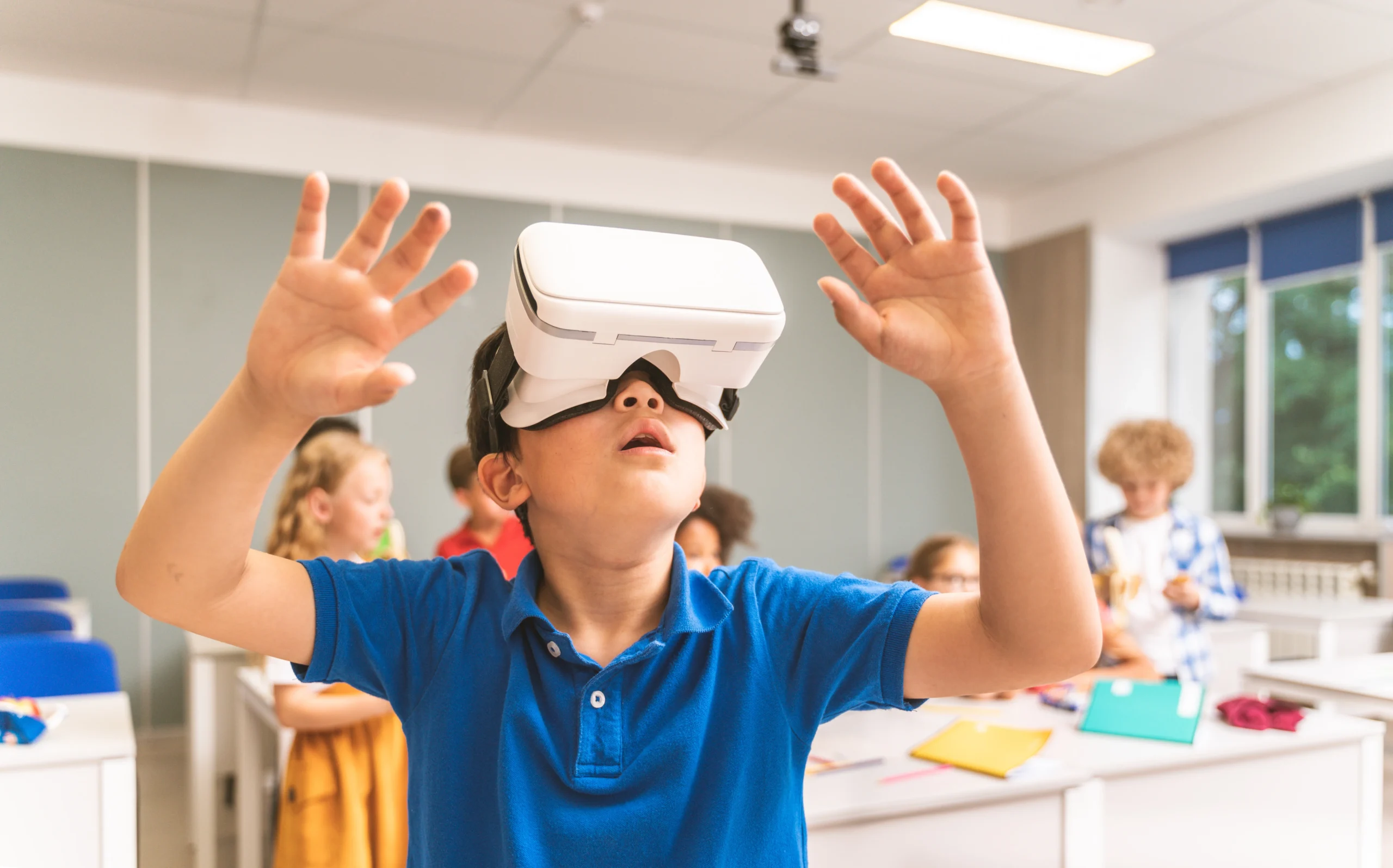The world of education is constantly evolving, seeking new and innovative ways to engage students and prepare them for a rapidly changing future. In the dynamic and forward-thinking region of the GCC (Gulf Cooperation Council), this pursuit is particularly evident. Here, amidst ambitious visions for technological advancement and human capital development, Virtual Reality (VR) learning, particularly through platforms like ClassVR, is emerging not just as a trend but as a transformative force, truly shaping the future of education.
Gone are the days when learning was confined to textbooks and static lectures. Today’s students thrive on interaction, immersion, and experiences that bridge the gap between abstract concepts and real-world understanding. This is precisely where VR learning shines, offering unparalleled opportunities that traditional methods simply cannot match.
What Makes VR Learning So Powerful?
Imagine dissecting a frog in a biology class without any mess, exploring ancient Roman ruins without leaving the classroom, or even taking a virtual trip to the surface of Mars. VR makes all of this, and more, possible. Here’s how it’s revolutionizing the learning experience:
Immersive Engagement
VR transports students directly into the learning content. Instead of passively reading about a topic, they become active participants, exploring and interacting with virtual environments. This deep immersion significantly boosts engagement, making learning exciting and memorable. Studies have shown VR learners can be significantly more engaged and emotionally connected to content.
Experiential Learning
The “learn by doing” philosophy is at the core of VR education. Students can practice complex procedures, conduct virtual experiments, and even experience historical events firsthand. This hands-on approach leads to deeper understanding and better retention of information. For example, medical students can practice surgical procedures in a safe, simulated environment, or engineering students can assemble complex machinery.
Visualization of Complex Concepts
Abstract ideas that are difficult to grasp from a textbook come alive in VR. From visualizing atomic structures to understanding intricate mathematical models, VR allows students to explore concepts in three dimensions, fostering a much clearer comprehension.
Accessibility and Inclusivity
VR breaks down geographical and physical barriers. Students can visit places that are otherwise inaccessible due to cost, distance, or safety concerns. This also offers incredible opportunities for students with diverse learning needs, providing a controlled and adaptable environment for learning.
Enhanced Retention and Outcomes
The combination of immersion, interaction, and visualization contributes to significantly improved knowledge retention. Research suggests that VR learners are faster to train and more confident in applying their learned skills. Some studies even indicate an increase in test scores after VR integration.
Key features that make ClassVR a game-changer for schools in the GCC
1. Standalone Headsets
ClassVR headsets are all-in-one devices, meaning no additional computers or complicated setups are required. This makes them incredibly practical for busy classrooms.
2. Teacher Controls (ClassVR Portal)
A robust teacher portal allows educators to easily manage and direct content to student headsets, monitor their progress, and ensure a focused learning experience. This gives teachers complete control over the virtual classroom.
3. Curriculum-Aligned Content
ClassVR offers a vast library of pre-made, curriculum-aligned VR and AR resources across various subjects, from science and history to art and geography. This readily available content saves teachers valuable time and ensures relevance.
5. Secure Storage & Charging
ClassVR headsets come in rugged storage and charging cases, ensuring devices are protected and always ready for use.
5. Ease of Use
ClassVR is designed with simplicity in mind, featuring a user-friendly interface for students and straightforward controls for teachers, minimizing the learning curve.
The GCC’s Vision for the Future of Education
The GCC nations are investing heavily in digital transformation and fostering knowledge-based economies. Education is a cornerstone of these visions, with governments actively promoting the integration of advanced technologies like AI, AR, and VR to enhance learning outcomes and prepare a skilled workforce.
The Middle East and Africa VR market is experiencing significant growth, with the education sector being a key driver. This indicates a clear recognition of VR’s potential to revolutionize teaching and learning across the region. With initiatives focusing on personalized learning experiences and aligning educational standards with labor market requirements, VR learning platforms like ClassVR are perfectly positioned to support these ambitious goals.
Addressing the Challenges and Embracing the Opportunities
While the benefits of VR are clear, some might wonder about potential challenges. Concerns such as initial costs, technical issues, or the need for teacher training are valid. However, solutions are constantly emerging. ClassVR, for instance, offers school-ready bundles and provides setup and training for educators. Furthermore, as VR technology becomes more accessible and affordable, and with increasing government investments in EdTech, these challenges are becoming more manageable.
The real opportunity lies in how VR complements and enhances traditional teaching methods. It’s not about replacing teachers, but empowering them with tools that can bring lessons to life, foster critical thinking, and spark a lifelong love for learning. Imagine students collaborating in shared virtual environments, solving problems together, and engaging in discussions fueled by truly immersive experiences.
Conclusion
VR learning, particularly with a comprehensive solution like ClassVR, is not merely a technological fad; it’s a fundamental shift in how we deliver education. In the forward-looking landscape of the GCC, where innovation and progress are paramount, ClassVR is set to play a pivotal role in shaping a generation of curious, engaged, and highly capable learners, ready to embrace the challenges and opportunities of tomorrow. The future of education in the GCC is undoubtedly immersive, interactive, and powered by the magic of virtual reality.
Frequently Asked Questions
What exactly is VR learning, and how does it differ from traditional teaching? VR learning immerses students in a simulated, interactive digital environment using VR headsets. Unlike traditional methods that rely on textbooks, lectures, and 2D visuals, VR allows students to actively experience and interact with the content, leading to deeper engagement, understanding, and retention.
1. Is VR learning suitable for all age groups and subjects?
Yes, VR learning is highly adaptable. ClassVR offers content across various subjects, from science and history to art and geography, catering to a wide range of age groups from primary to higher education. The immersive nature makes complex concepts easier to grasp for younger learners while offering advanced simulations for older students.
2. What kind of content is available with ClassVR?
ClassVR comes with a vast library of curriculum-aligned VR and AR resources, including 360-degree videos, interactive 3D models, explorable scenes, and virtual field trips. Teachers can also upload their own custom content, allowing for highly personalized lessons.
3. How difficult is it for teachers to integrate ClassVR into their lessons?
ClassVR is designed with simplicity in mind. Its standalone headsets and intuitive teacher portal make it easy to manage and deliver VR content without extensive technical knowledge. ClassVR also often provides setup assistance and training for educators to ensure a smooth integration.
4. Are there any health or safety concerns with using VR headsets in schools?
Leading VR education platforms like ClassVR prioritize student safety. Headsets are designed for comfort and ease of use. It’s recommended that VR sessions be kept to moderate lengths and teachers maintain supervision to ensure appropriate content and usage, aligning with general screen time guidelines.
5. What about the cost of implementing VR in schools, especially in the GCC?
While there’s an initial investment, the long-term benefits in terms of student outcomes and engagement often outweigh the cost. ClassVR offers various sets (e.g., 8 or 30 headsets) and subscription models for content. With the GCC’s strong focus on educational technology investment, funding and support for such initiatives are increasingly available.
6. Does VR replace the role of the teacher in the classroom?
Absolutely not. VR is a powerful tool that enhances the teacher’s role. It provides immersive experiences that teachers can leverage to bring abstract concepts to life, spark discussions, and facilitate deeper learning. The teacher remains crucial in guiding the learning process, fostering critical thinking, and ensuring the technology supports educational goals.
7. How does ClassVR ensure student privacy and data security?
ClassVR prioritizes privacy. The headsets often do not require individual student logins for most experiences, and personal data collection is minimal and focused on technical performance rather than identifiable user information. The system is designed for teacher control, ensuring a secure and managed learning environment.



